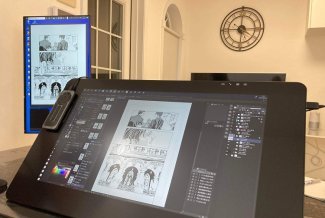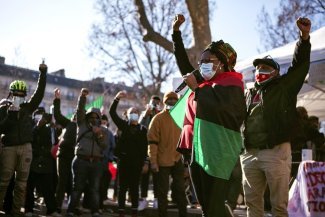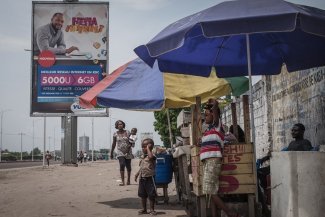We are undoubtedly witnessing a shift in the regional chessboard, but it is not necessarily good news. Homs, Syria, January 2018.
We have grown accustomed, over the decades, to seeing the Middle East as a region dotted with artificial countries, with serious ethnic and religious divisions, plagued by widespread corruption, despotism, internal instability and tensions between neighbouring countries, together with low levels of welfare and security. It is beleaguered, in addition to all this, by the unyielding interference of regional and global powers that, without entering into direct conflict, work to manipulate diverse local actors to serve their own interests. Although none of this looks set to change, we are undoubtedly witnessing a shift in the regional chessboard. But it is not necessarily good news.
Taking Syria as a point of reference, and assuming that time is inexorably running in favour of the al-Assad regime, our attention should be focused on three levels.
The first is local, and if there is one thing we cannot fail to recognise, almost eight years after the conflict broke out, al-Assad has shown an iron will to resist, at all costs, which – together with the direct help from Moscow, Tehran and the Lebanese Hezbollah militia – has left him in control of most of the country. And although there may well still be pockets of resistance in the province of Idlib and in the north-eastern part of the country, everything would seem to indicate that their elimination is only a matter of time. The shift, at this level, does not necessarily take us back to square one, with all the problems this implies, and a great deal of violence still lies ahead.
At the second level, where the regional powers move, although no one is able to declare victory, Iran is clearly closer than its rivals to achieving its goal.
While Saudi Arabia, the United Arab Emirates and other Gulf countries have been busy supporting and arming local militias that have failed to defeat forces loyal to the Syrian regime, Iran has been successful in pushing ahead with its bid to keep Syria within its sphere of influence, thus securing its link with the Lebanese Shia Hezbollah militia and raising its chances of one day being recognised as a regional leader. Clear signs that other regional actors are beginning to recognise the state of play include the decision taken by Bahrain and the United Arab Emirates to reopen their embassies in Damascus and the start of visits by foreign leaders, such as the controversial Sudanese president Omar al Bashir, based on expectations that Syria will soon be readmitted to the Arab League, from which it was expelled at the end of 2011, and that the rest of the governments (western included) opposed to al-Assad will suffer from a convenient collective amnesia that will lead them to accept him as a valid interlocutor.
Turkey, US, Russia, Iran – and shifting strategies
Should more data be needed to corroborate this move towards pragmatic acceptance of an undesirable reality, Turkey is probably the best example. Ankara (aligned by force with Moscow and Tehran) has gone from its initial position of being totally opposed to al-Assad, spurred by dreams of a Sunni government being installed in Damascus, to now accepting that he will remain in power. Its main concern right now, after bearing the burden of more than three million Syrian refugees on its soil for several years, is how to stop the emergence of the Syrian Kurdish militias (from the PPU, People’s Protection Units), united within the Syrian Democratic Forces that Washington turned into the main military instrument to dismantle the pseudo-caliphate established in June 2014 by Da’esh (IS) in the eastern half of the country. What Washington sees as a useful ally in the strategy to combat jihadism, Ankara sees as the incarnation of a local branch of the terrorist group PKK, which it has been trying to eliminate for years.
Turkey would now like to take the opportunity to finish off the task, striking, on Syrian soil, against those it considers terrorists; but it knows that any such move would rely on the approval of both Washington and Moscow. Its military plans include achieving a military presence on a strip of Syrian territory closest to their common border, both to bolster its security against the jihadist groups operating there, as well as to embark on the return of many of the refugees it is sheltering on its soil and to provide itself with one more trump card with which to influence Damascus.
Finally, at global level, where the only big players are the United States and Russia (China is still a very secondary player in the region), it has long been clear that it is Moscow that is leading the game.
The decision announced in December 2018 by Donald Trump to withdraw the 2,000 or so military personnel from Syria (and probably Afghanistan too) is just the latest sign of a shift already started by his predecessor in the White House. The United States has no crucial interest in the Syrian conflict and its barely hidden intention is to get out of the quagmire into which George W. Bush’s militaristic adventurism led his country within the framework of the nefarious “war on terror”. The main focus of the US agenda in the region today is on consolidating support for Israel, eliminating the jihadist threat and provoking regime change in Iran. If we add to this Washington’s concern about the emergence of China as a contender for world leadership, it immediately becomes clear that Trump is seeking to reduce its footprint in the Middle East (which does not mean removing it), to regain room for manoeuvre and to concentrate on the Indo-Pacific area.
Russia, for its part, is striving to take advantage of the US stalemate to recover an area of influence in eastern Europe and central Asia that it has always considered its own. As Vladimir Putin once again demonstrated at the meeting on 14 February with his Turkish and Iranian counterparts, Moscow is currently the regional factotum. With his military and political involvement, Putin has managed not only to keep al-Assad in his post, but also to become an indispensable interlocutor for Israel (in need of someone to stop an Iran that is moving increasingly close to the Golan Heights) and for Turkey (to which he is preparing to sell the sophisticated S-400 anti-aircraft missile system, to the displeasure of Washington and NATO as a whole).
The shift in the regional chessboard is also having a very direct impact on Iran. Once again in the role of “bad guy”, following Trump’s decision to withdraw from the 2015 nuclear agreement, it is patently clear that Washington is seeking to topple the revolutionary regime established 40 years ago.
With the military option ruled out, what is looming on the horizon is a US-led effort – which the European Union will struggle to avoid, despite the opposition expressed at the meeting on 14 February in Warsaw, where Vice President Mike Pence and Secretary of State Mike Pompeo tried to align more than 60 countries against Tehran, with a view to eliminating a player that has already been in the firing line for a long time. The main weapons of this strategy of intimidation and overthrow, which Saudi Arabia and Israel are more than happy to back, include the increase in economic sanctions and blocking Iranian oil and gas sales, in the hope of sparking a popular uprising that will make the regime collapse from within. The same strategy also includes cyberattacks and the manipulation of critical sentiment towards the regime, be it among the Baluchis or Iranian Arab minorities.
And so, as we wait to see whether Israel’s Prime Minister Benjamin Netanyahu will be re-elected to his post and if Trump announces his peace plan for Palestine, we are witnessing moves that until recently seemed unthinkable, be it the visible rapprochement between Tel Aviv and Riyadh (along with other Arab countries) or the negotiations between Washington and the Afghan Taliban (sidelining the government in Kabul).
Those who have eyes to see…










